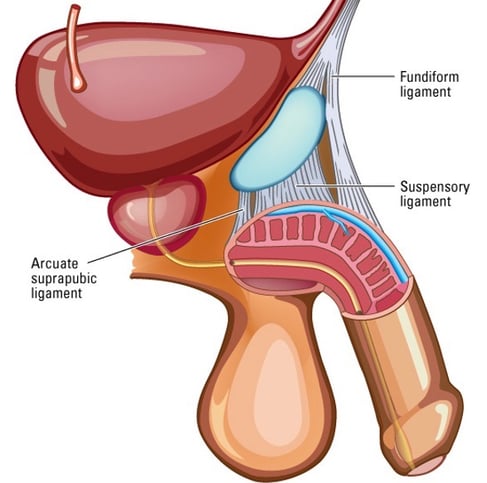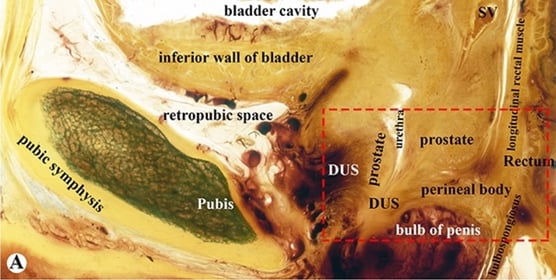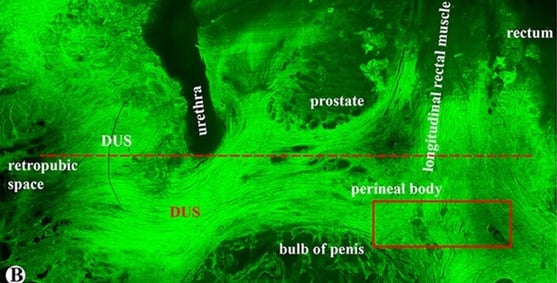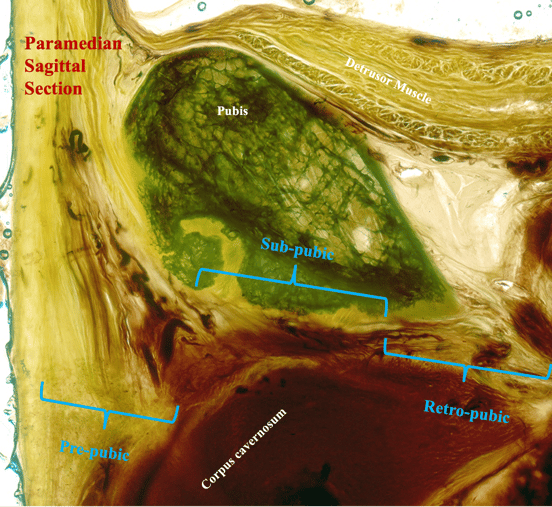Destabilising Evidence
Outdated Concepts
used by Cosmetic Surgeons
The Penile Suspensory Ligament (PSL) is a key structure that helps stabilize the penis in its natural position when flaccid and supports it during erection. This ligament plays an essential role in keeping the penis attached to the pubic bone, allowing for proper function during intercourse. When the penis becomes erect, the PSL helps maintain stability, enabling effective penetration and ensuring that the penis stays at the correct angle during sexual activity.
Until recently, it was believed that the PSL was made up of three main parts:
Fundiform Ligament
Suspensory Ligament Proper
Arcuate Subpubic Ligament


The Risks of Penile Suspensory Ligament (PSL) Division Myths vs. Reality
For decades, cosmetic procedures involving the cutting of the penile suspensory ligament (PSL) have been marketed as a way to increase penile length. In reality, these surgeries only create the illusion of a longer penis by slightly increasing the distance between the pubic symphysis (PS) and the base of the penis. While this may cause the flaccid penis to appear marginally longer, it does not actually lengthen the penis itself. The erect length remains unchanged, and worse, patients are left with a condition called PSL Deficiency, which can lead to significant complications.
The False Promise of Cosmetic Penile Enlargement Surgery
The theory behind cutting the PSL is based on outdated anatomical beliefs. Proponents of this procedure claim that the deeper Arcuate Ligament is the main support structure of the penis, and as long as it remains intact, the division of the Fundiform and Suspensory ligaments will not cause any functional issues. However, this reasoning is flawed, as modern anatomical research has shown that the suspensory ligament plays a crucial role in maintaining penile stability during erection. Cutting these ligaments does destabilise the penis, leading to functional problems that cosmetic surgeons downplay or ignore.
No Real Length Gain: While there may be a small, temporary increase in flaccid length, the actual length of the penis remains the same, the erect length is unchanged and penile shortening may occur.
False Claims of Stability: The claim that dividing the superficial ligaments won’t destabilize the penis has been debunked, as these ligaments are integral to keeping the penis stable during erection.
Low Patient Satisfaction and Questionable Outcomes
Published outcomes from these surgeries are inconsistent, and patient satisfaction is often low. In one series of 42 patients, only 35% reported being satisfied after the procedure and only an average gain of just 1.3 cm in stretched penile length. Some reports promise greater gains, but the distinct lack of patient-reported outcome data and contradictory results being published outside of 'cosmetic' or 'aesthetic' medical journal, raises the irreconcilable concern that this information is unreliable.
Complications of PSL Deficiency and Penile Instability
Men who undergo PSL division often experience a range of complications related to the instability of the erect penis. This is not caused by erectile dysfunction in the traditional sense but by the inability to maintain a stable erection for penetrative intercourse. The instability is due to the disconnect between the pelvis and the penis after the PSL is cut, leading to problems such as:
Penile Instability: The penis becomes unstable during intercourse, often slipping out or requiring manual assistance to maintain penetration.
Increased Risk of Penile Fracture: An unstable penis is more prone to buckling during intercourse, significantly increasing the risk of penile fracture, a medical emergency requiring surgery.
Silent Microtrauma: Repeated buckling can lead to microtraumas in the erectile tissue, which may not be immediately noticeable but could eventually result in conditions like Peyronie’s disease, characterized by painful curvature of the penis.
Penile Curvature and Rotational Deformity: Asymmetry in ligament division or postoperative scarring can result in curvature or rotation, causing the penis to point downward or to one side.
Additional Functional and Sensory Complications
The functional consequences of PSL division extend beyond instability. Patients are at risk for further complications, including:
Erection Angle Change: The penis may lose its upward angle during erection, causing it to droop or point downward, which can make intercourse uncomfortable or challenging.
Erectile Dysfunction (ED): The destabilization of the penis can interfere with its ability to trap blood during an erection, contributing to Veno-occlusive ED, where the penis cannot maintain rigidity. This type of ED can result in significant atrophy of the corporal smooth muscle.
Loss of Sensation: Nerves damaged during the surgery can result in a permanent loss of penile sensation, further reducing sexual satisfaction.
Chronic Pain: The unnatural traction placed on the remaining penile nerves after PSL division can cause chronic pain, particularly during everyday activities or sexual intercourse.
Penile Shortening: Abnormal reattachment of the cut ligaments can cause the penis to retract, leading to penile shortening over time.
Aftermath of Cosmetic Penile Surgery: Urologists Repairing the Damage
There is a clear disconnect between the anatomical understanding of cosmetic and plastic surgeons performing penile suspensory ligament (PSL) division and the suboptimal outcomes men experience after these procedures. Many patients are left with significant complications, often requiring urologists to step in and repair or even reconstruct the damaged ligament.
Several techniques for PSL ligament repair have been described for men suffering from these complications. Common methods include:
Placing sutures between the pubic bone and tunica albuginea to restore stability.
Harvesting autologous fascia (tissue from the patient’s leg) to create a new ligament for improved support.
Interestingly, one urological publication noted an average improvement in erection angle of 80 degrees after reconstruction was accompanied by an average penile shortening of 1 cm. This raises questions about the accuracy of cosmetic surgeons' claims of providing an average length gain of 4 cm without compromising erection angle or stability...
Urologists often face the difficult task of cleaning up the complications left behind by cosmetic surgeries, highlighting the need for safer, more anatomically sound approaches to penile enhancement.
New Anatomical Insights: Redefining Penis Suspension for Safer Penis Enhancement
Concerned by the inconsistencies surrounding penile suspensory ligament (PSL) anatomy and its role in penile enlargement surgeries, Dr. Ross Calopedos, a UroFill® provider, sought to clarify these misconceptions. A clear understanding of PSL anatomy is crucial for ensuring safe and effective penile enhancement and providing patients with the accurate information they need to make informed decisions.
To address these discrepancies, Dr. Calopedos joined forces with Professor Ming Zhang, from the Department of Anatomy at the University of Otago. Together, they employed a novel technique combining epoxy-sheet plastination with confocal-laser microscopy.
This method offers superior insight compared to the techniques used to describe the old understanding of PSL anatomy - namely traditional dissection, which distorts anatomy, or histological examination, which limits the field of view. Plastination preserves the in-situ architecture of tissues while allowing for the tracing of connective tissue across broad anatomical areas. Using this cutting-edge technology, Dr. Calopedos analyzed data from six male cadavers, providing a more detailed and accurate understanding of the PSL.




Select areas examined using stereoscopic microscopy and scanned at high-resolution
Collagen/elastin/myofilaments endogenously autofluorescence under 488nm-confocal-laser microscope
A New Classification System for the PSL Anatomy
Based on this groundbreaking research, Dr. Calopedos proposed a new classification system for the PSL, reflecting the distinct histoarchitectural origins of its different components:
Prepubic: Fibers originating from the abdominal wall musculature and fascia.
Subpubic: Ligamentous fibers inserting directly into the tunica albuginea, including previously undescribed decussating fibers that cross for enhanced stability.
Retropubic: Musculotendinous fibers extending from the fascia of the urogenital diaphragm, also contributing to the tunica albuginea.


Contrary to cosmetic claims, these findings debunk the long-held belief that the Arcuate Ligament (AL) is the main penile support structure. Not only does the professed arcuate ligament have no role in phallic support, but it does not attach to the penile structures at all!
In reality, the subpubic component of the PSL apparatus—often divided without thought—is the key structure responsible for penile stability. It is the only component of the PSL that connects bone to the tunica albuginea. Cutting this ligament compromises the functional integrity of the penis, similar to how an anterior cruciate ligament (ACL) injury destabilizes the knee.
Implications for Penile Enlargement Surgery
Contrary to the promises of cosmetic procedures, this new understanding reveals that dividing the subpubic aspect of the penile suspensory ligament can lead to significant biomechanical consequences. The assumption that penile length can be increased through cosmetic surgery without functional compromise is unfounded. These insights underscore the importance of relying on accurate anatomical knowledge to inform safe and effective penile enhancement techniques.
Dr. Calopedos’s research not only redefines the PSL but also challenges the anatomical rationale behind current PES techniques, advocating for safer, non-invasive methods that prioritize both patient safety and functional outcomes.
Verdict on PSL Division: Not Worth the Risk
Suspensory ligament division is an outdated procedure that offers little to no real benefit in terms of length gain and comes with a high risk of complications. Despite cosmetic surgeons' claims, cutting the PSL can lead to erection instability, deformities, and erectile dysfunction. Patients considering penile enhancement should be fully aware of the risks involved and seek safer, non-invasive alternatives like the UroFill® technique, which enhances girth and flaccid length without compromising the natural structure or function of the penis.
Key Complications to Be Aware Of:
Change in Erection Angle: The penis may no longer maintain its natural upward angle, making intercourse difficult.
Erection Instability: Difficulty maintaining penetrative intercourse without manual assistance.
Rotational Deformity: Post-surgical scarring may cause the penis to point downward or to one side.
Penile Shortening: Ligaments can reattach abnormally, causing the penis to shorten.
Loss of Sensation: Damaged nerves can result in reduced penile sensation.
Chronic Pain: Traction on the penile nerves can cause ongoing pain.
New Veno-Occlusive Erectile Dysfunction: The loss of stability can impair the penis’s ability to maintain an erection.
In conclusion, while suspensory ligament division may sound like a quick fix for penile length, it comes with numerous risks that outweigh the benefits. Men should consider safer, evidence-based alternatives like UroFill®, which can enhance confidence without compromising penile function.

Get In Touch
If you have specific questions, please fill out the form below for Dr. Ross Calopedos and his expert team to reach out to you promptly. We're here to help guide you through every step of the process.
To book in for your Men's Health Consultation and Pre-UroFill Assessment, call East Sydney Private Consulting Suites at 1300 017 888 or (02) 9145 2177 to schedule your in person or Telehealth appointment with Dr. Ross Calopedos. Start your journey to better men’s health and a more confident you today!
Have questions or ready to take the next step?
Email Enquiries: contact@urofill.au
Phone: 1300 017 888
Copyright © 2024 Dr. Ross Calopedos UROFILL® Australia. All rights reserved


UroFill® is Australia’s leading penis enlargement clinic, specialising in evidence-based techniques rooted in advanced urological expertise and decades of experience in penile surgery. Serving Sydney and Australia-wide, Dr. Ross Calopedos offers comprehensive urological services alongside penile enhancement. UroFill® Australia is your one-stop shop for all penile health concerns, delivering only scientifically-backed treatments and trusted medical advice.
Secondary Phone: (02) 9145 2177
